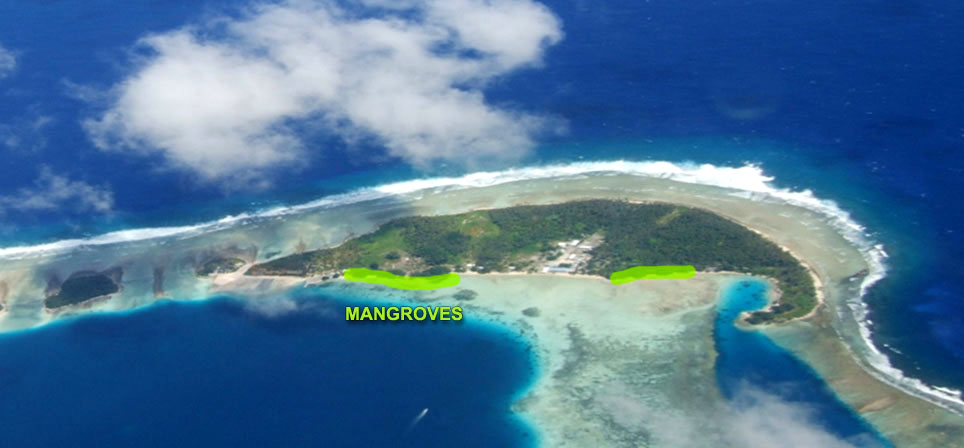Mangroves

Mangroves are the trees and shrubs that can grow in salt water. In the Marshalls, they are usually found in wet depressions in the centers of islets (pat). They can also grow in sheltered areas below high tide on the shores of islets. Thick mangrove branches and roots help break waves before they reach shore.
Whether to plant mangroves
It is very difficult to restore mangroves. It is most important to protect the mangroves that are already growing. If you do want to try planting, begin where you have a supply of “propagules” (viviparous fruits, meaning seeds that have sprouted roots before falling from the mother tree). Consider planting mangroves where they have grown in the past, and where lagoons are sheltered and shallow.

Where to plant: different species belong in different zones
- Eoeak or Būļaboļ (Rhizophora) is called a fringe species because it can grow on the seaward edge of a mangrove forest. Plant large propagules at mean sea level, about halfway between the high tide and low tide points, where it will be inundated by any day’s high tide. If it is an El Niño year, the sea levels might be unusually low, so plant them where it is shallow, because when normal weather returns, the water will be deeper.
- Kōnpat or Būļabōļ (Sonneratia) and Joñ (Bruguiera) are usually found in inland swamps (pat) in the Marshalls. You could try planting large propagules of joñ closer to shore than the eoeak, where they will be flooded by medium-high tides.
- Kimeme (Lumnitzera) is called an interior species. It is also mostly found in pat. You can try planting kimeme seedlings close to the shoreline, where only high tides will flood them.
- Kōñe (Pemphis) is a mangrove associate that grows closest to shore but can tolerate flooding by the highest tides.
When to plant
If you plant coastal trees or shrubs
- Plan ahead. Soon after a king tide is a good time, to allow a few months for seedlings to take root before the next king tide. Check the tide charts.
- Sea levels over the coming months, based on large-scale processes (not including tides, local tropical storms or tsunamis) are shown here.
- Don't plan a planting project during an El Niño Year 0 because there is a high risk of storms that can wash away your plantings.
- Postpone your outplanting day if inundations are predicted by local radio.
- Short-term (weekly) forecasts of high sea level based on tides and wave trains from far-away storms are available for Majuro and Kwajelein.
Technical advice on planting mangroves
Pages 39-42 of the ”Coastal Change Toolkit” provides basic advice in the context of other options for coastal management.
This Mangrove Restoration pamphlet (7 MB) gives practical advice from Indonesia, where foresters have successfully planted the same mangrove species as are found in the Marshalls.
This Decision Makers’ Guide (6 MB) offers more considerations about mangroves for coastal defense worldwide.
Case studies
Outplanting mangroves in atolls of Chuuk
Experience from Sleeper Sared
On three atoll islets, Sleeper planted mangroves along the lagoon-side shore in a strip one mile long. He planted four rows, with seedlings 2–3 feet apart. He gathered the propagules (sprouted seeds) locally and planted them directly into the sand or sediment. After one year, 75% (three quarters) were surviving. Sleeper says seagrass is an indicator of sufficiently calm waters with enough sediment.
On another atoll islet, the mangroves all died, because the currents were too strong.
Sleeper says: If there is a current and not enough sediment to hold the propagules when they are planted, put out rocks or wire boxes filled with rocks. Wait for sediments to be deposited by the currents. Plant propagules into the accumulated sediments.
Sleeper says: Another technique for areas without much sediment is to use heavy paper bags such as cement sacks or some rice sacks. (Ordinary paper bags are not strong enough.) Fill the bags with sand and seaweed and plant propagules in them in a nursery. They are ready after they take root in the sacks, but before roots burst through sacks and root in the ground. Outplant them in holes dug into sediment or in niches between rocks.
Planning to plant eoeak on the coast of Ailuk
The Ailuk Atoll Marine Resource Management Advisory Committee was interested in planting mangroves on the coast of Ailuk to reduce shoreline erosion. Rhizophora was selected as the most appropriate species for coastal planting, but it would have to be brought from other atolls. A planting site was chosen (1) between high and low tide (2) at a spot sheltered from wind and waves (3) with soft sediments good for planting propagules (4) from where the tide flowed into the lagoon, not the ocean. The project’s Natural Resource Assessment Survey explains the considerations and plans for mangrove planting.
Planting mangroves in Kiribati
Kiribati, like the Marshalls, is a nation of atolls, where sea level rise and coastal erosion are of great concern. Mangroves are an important resource in Kiribati and a mangrove planting program has been ongoing for at least twenty years. Rhizophora stylosa (a close relative of eoeak) is one of the most important species for planting. Propagules are planted along shorelines and causeways. For a short description of Kiribati mangrove planting, see this newsletter from the International Society for Mangrove Ecosystems.
